


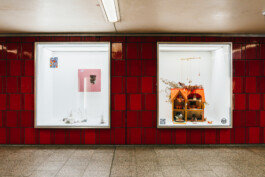
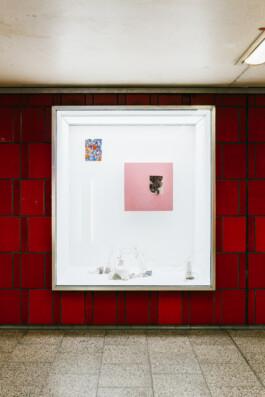
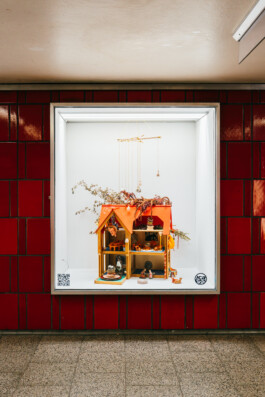
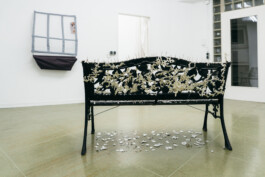
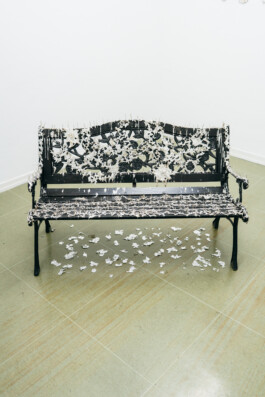
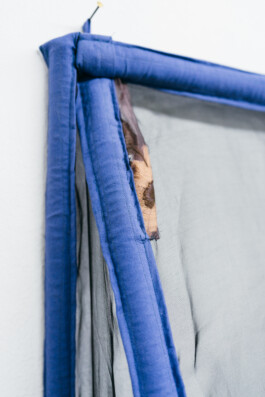
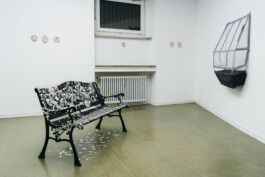
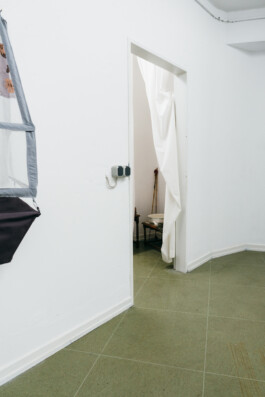
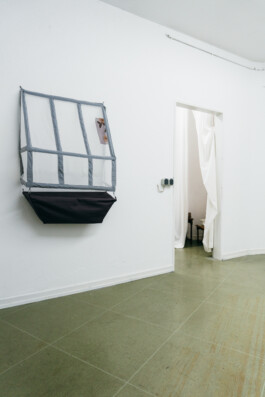
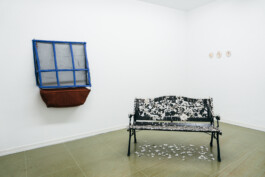
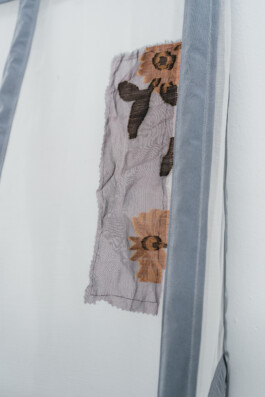
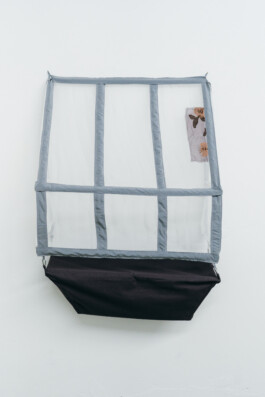
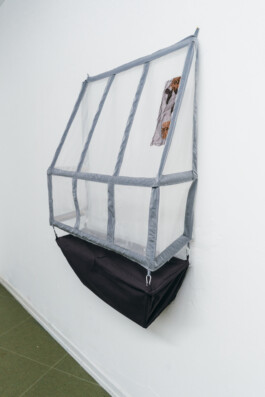
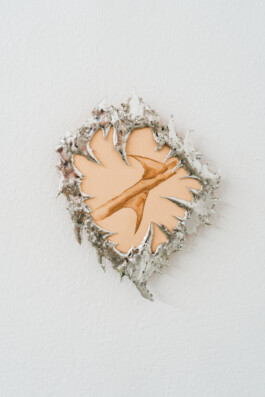
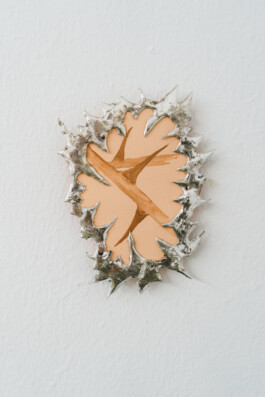
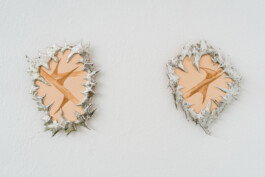
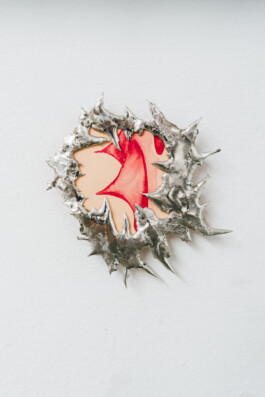
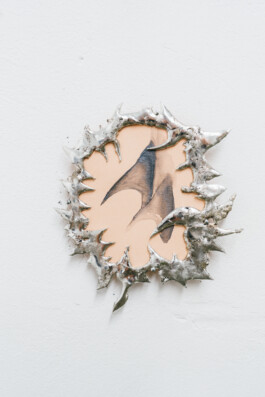
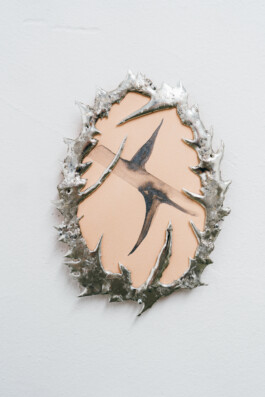
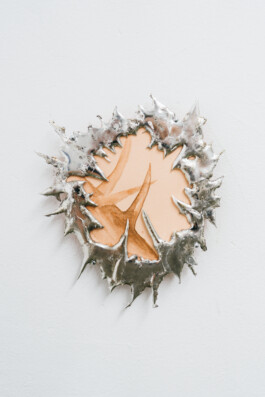
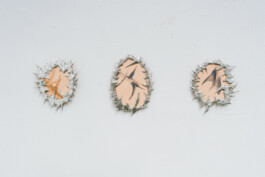
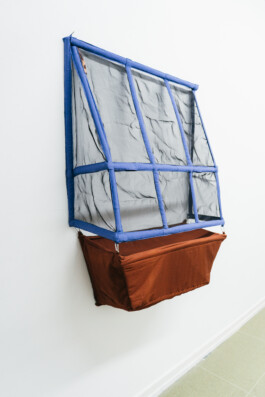
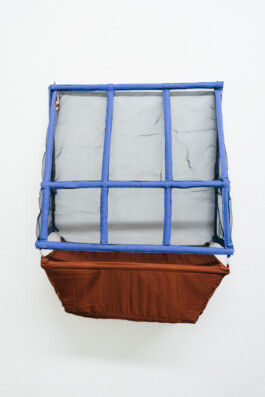
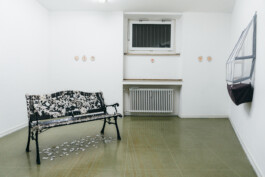
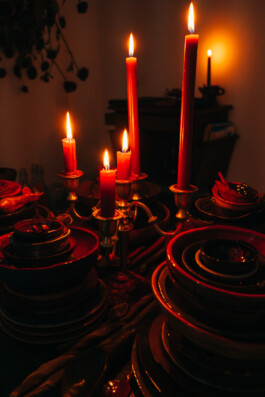
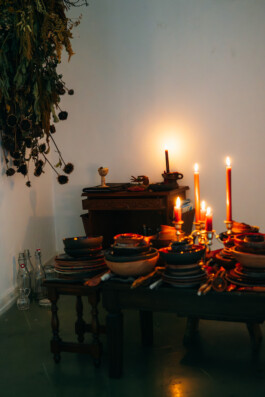
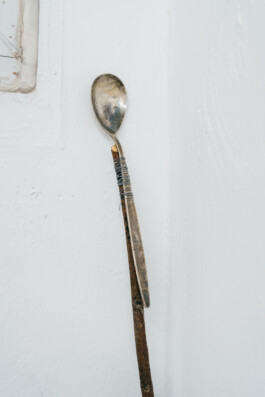
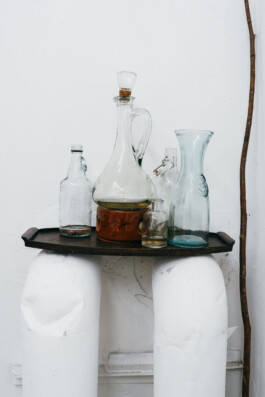
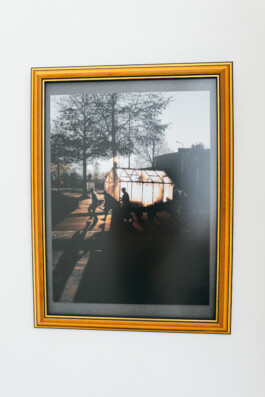
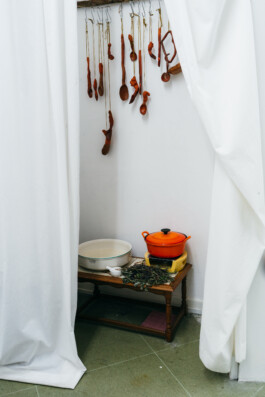
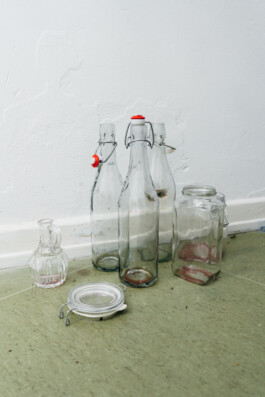
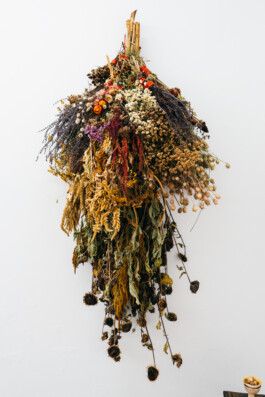
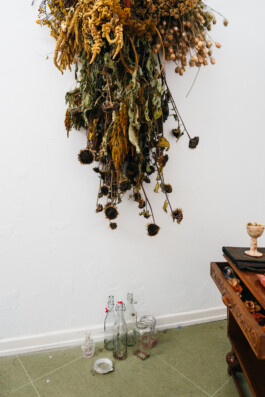
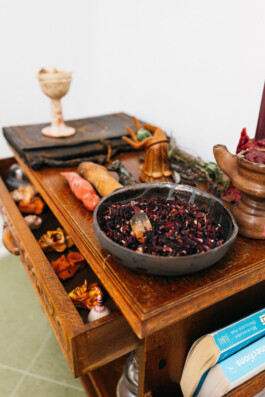
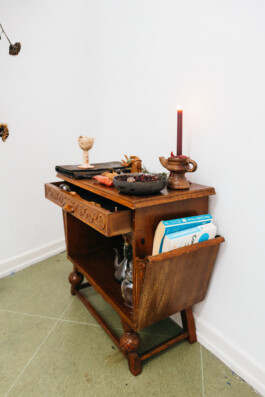
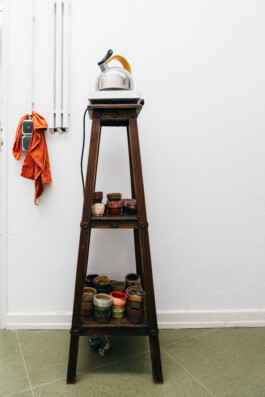
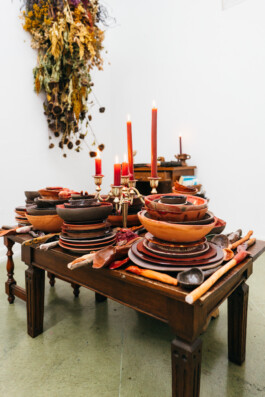
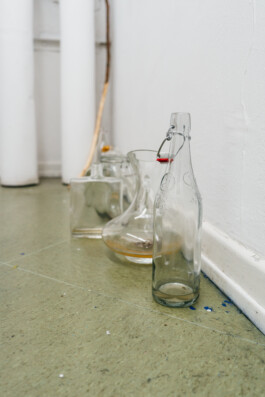
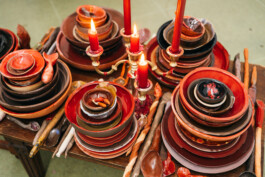
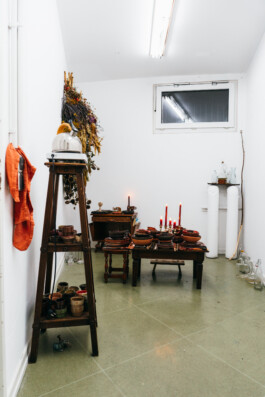
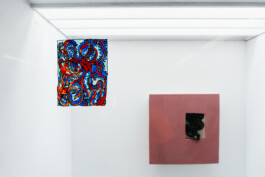
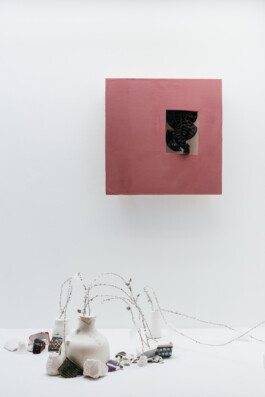
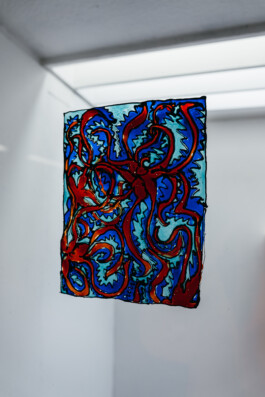
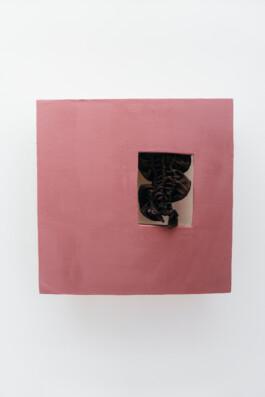
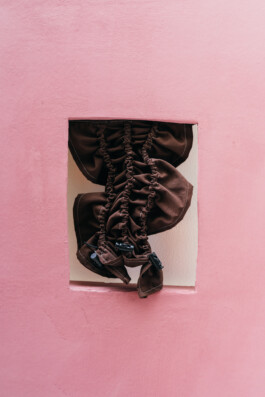
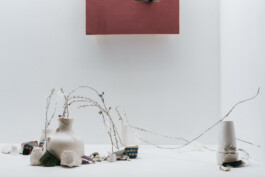
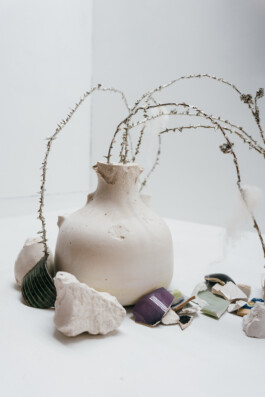


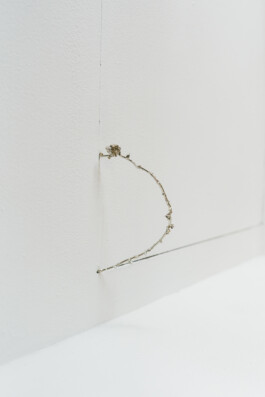
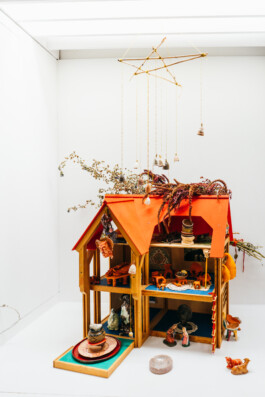
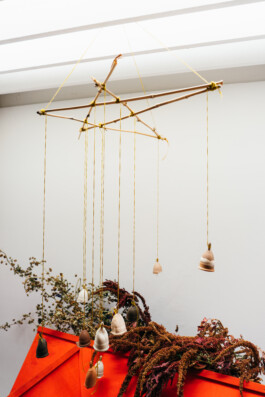
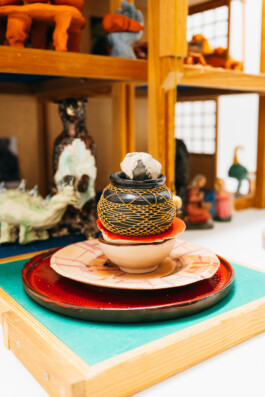
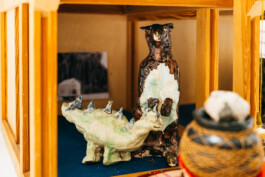
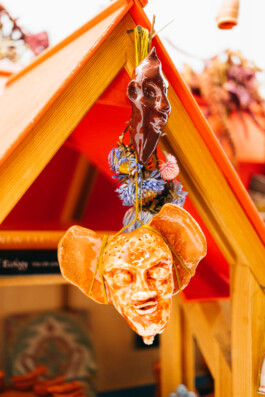
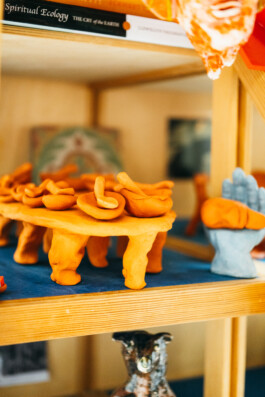
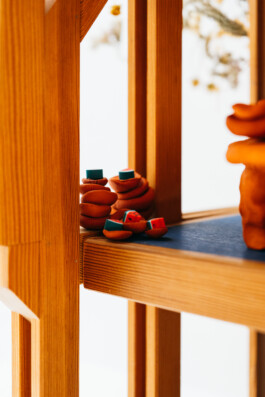
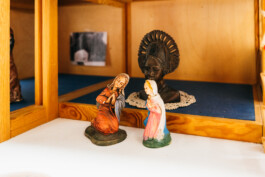
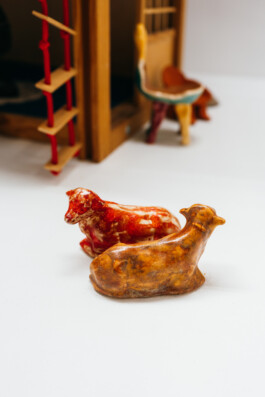
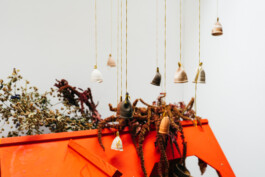

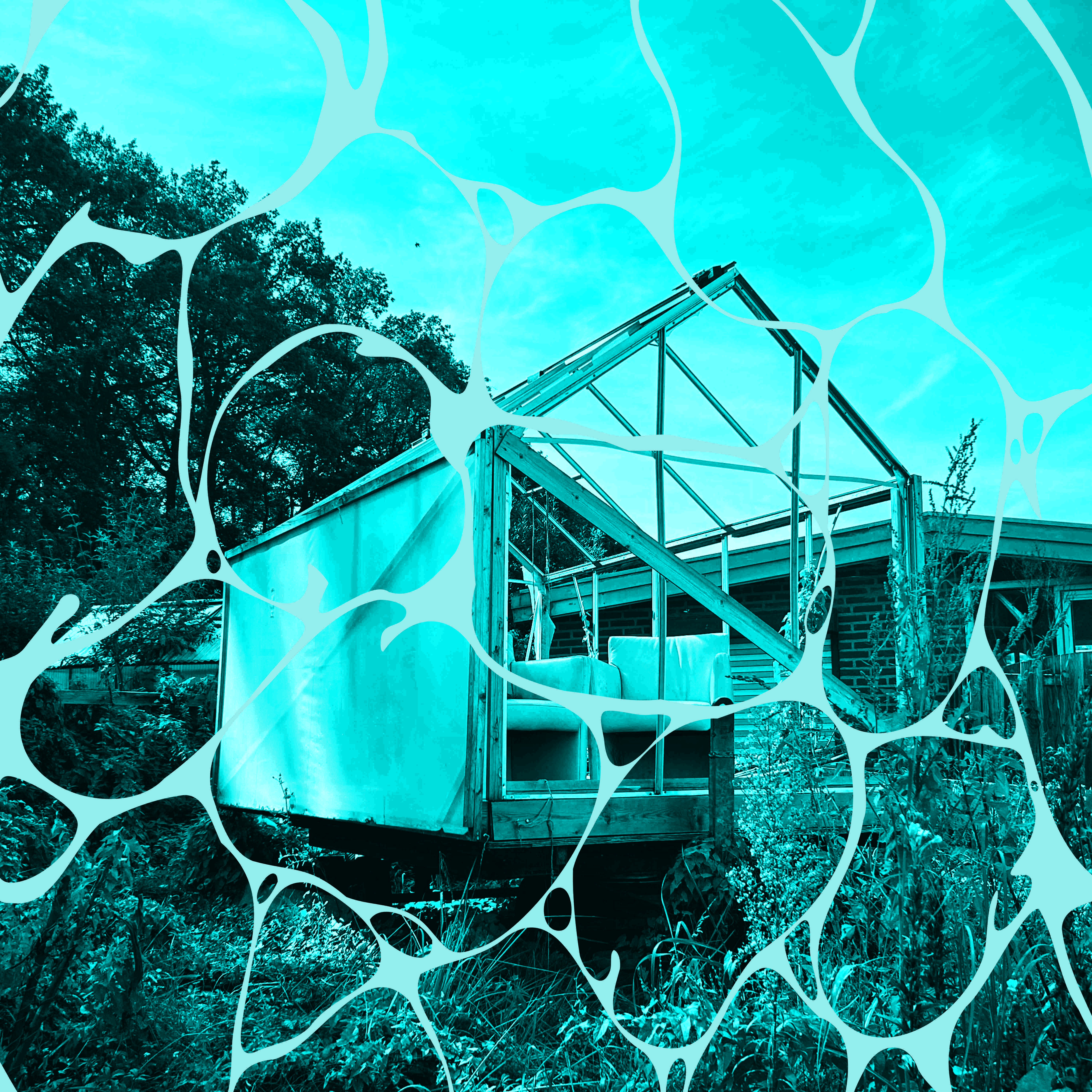
Nadjana Mohr
Scratch, love, let gravity win, 2025
Romantically inviting – or as a defensive construction against any long-term settlement of humans and animals – images of burning benches in fire and rubble, piled up meters high, they fill up screens. In times of crisis, the bench becomes a barricade, a demarcation of the terrain of a conflict, a refuge – a missed refuge. A bench is a meeting place and negotiates the merging and demarcation of users in equal measure. With each installation, a little more material is added.
untitled (Framed Hooks), 2025 Hooks In My Mind / 2025
The edition Hooks In My Mind outlines the mechanisms between physical defence and aesthetic attraction in a small collection. It contains sketches of thorns and spikes based on AI, as well as stock templates of roses, acacias, holly, blackberries, sloes and black locusts, all with a shiny metallic finish. The cover is made of tin on recycled cardboard and contains tinted watercolour paper. By covering sharp shapes and translating them into metal, a piece is created that negotiates the boundaries between approachability and fragility, falling somewhere between an art object and a booklet.
Gesa Kolb
Oriel I, Oriel II , 2025
Inspired by bay windows (oriel) and conservatories that Kolb found in various cities, Oriel I and II appear as a hybrid of architecture and costume. Based on the construction methods of Victorian crinolines, the two wall objects simultaneously open up a volume and the space behind them. The fragility of the fabrics is also intended to refer to the fragility of the rooms that the oriels enclose/protect. The mostly single-walled glass panes of the oriels are emphasized by the thin silk of the ‘oriel windows’, which have been patched in some places and replaced with different ‚glass’ piecings. The underside of the bay windows also does not convey stability, but rather becomes a pendant attached to the ‘window’ with a carabiner hook.
Darcy Neven
Search for meaningful rituals, Pt 1., 2025
“A search for meaningful rituals, to honor the sacred human lives that are being sacrificed every day. Creating space to allow Death to teach us: to awaken us to the reality of a system whose atrocities know no bounds. In acknowledging Death, I want to honor my own aliveness. My capability of hope and love.
So, in a world with so much war, violence, greed and separation: I invite people to eat together.
Because everyone who grew up in a conflicted home, knows the dinner table is not a neutral territory. Many of us have complicated relationships with food and our bodies. We rarely know where our food is being grown, nor who grew it. In Sudan more than 50 000 children have starved to death. In Gaza, food is one of the biggest weapons of the genocide. More than 1/3 of the food being grown or produced, is being wasted, while millions go hungry. Food is political.
Growing food and tending to a garden is political, not a hobby. It is a protest and it is the solution at the same time. When we become aware, the dinner table can become a weapon of change. Food can be a bridge, to slowly mend the disconnect the system feeds on. And to remember the magic in everyday life.
The wisdom of the water will make us remember our capability to move with what is. It will gently heal our bodies, yet has the power to carve a new path over time: just like our choices.
Guten Appetit, smakelijk eten: May it nourish your soul.”
Darcy Neven, Cologne 2025
Vitrines
Gesa Kolb
Clematis, a Window Frame and a Curled Curtain, 2025
The installation ‘Clematis, a Window Frame and a Curled Curtain’ plays with the conditions of the exhibition space and the motif of still life. The display case, similar to a bay window (see ‘Oriel I + II’), serves as both a window and a stage. The work creates a doubling in several aspects. The format of the window colour drawing corresponds in size to the cut out part of the wall object, and the curved shapes of the abstracted drawing of clematis seeds are repeated in the twisted form of the curtain in the ‘window frame’. Kolb discovered the clematis motif during walks in and around the city, where it grows wild, mostly in abandoned, undeveloped places such as former industrial areas and construction sites. It is often found together with wild blackberries, to which Nadjana Mohr's work in the same display case alludes.
Nadjana Mohr
Portal, 2025
The installation Portal focuses on familiar and mythical (inner) places. In times marked by unrest, the work conveys connections between ancient myths and customs and those of the present. Shepherds would send their flocks under blackberry bushes so that all evil would stick to them, or they would weave the blackberries into a wreath so that those wearing the blackberry crown could recognize witches. The work Portal seeks connections to current social developments and trends, reinterpreting mysticism and conjuring up modern superstitions. Portal aims to be the gateway to the sought "missing piece"—the vanished element in the enchanted—which, as expected, rests in the grandparents' basement or in the untidy part of the garden shed—or in the White Cube.
Darcy Neven
I want to go back playing, 2025
In an interview, the Palestinian journalist Bisan spoke about her 5 year old niece, who was sad and tired about the dire situation they have been living in and mentioned that she “wanted to go back to playing.” As all children should.
And adults too. As I was building my “professional artistic practice” I was noticing my own playfulness becoming less. High expectations, fear to fail or make mistakes and moving from the mind took the lead. Pleasure and joy became concepts of the mind. Needless to say: I was becoming more and more unhappy. This Palestinian child broke my heart, but inspired me to reconnect to this magical and hopeful, childlike part in myself.
When I was a child, my uncle build a wooden dollhouse for me and my sister. It was very big, with a balcony, windows and carpet floors. When we were older the house was sold without our permission but the house stayed with me, as a ghost, a lost family member or a secret longing.
I was fantasizing about re-creating this house, but even more magical.
Without prefabricated, plastic furniture that unconsciously conditions my future children on how a home should look like or how life should be lived. But a home that is warm and welcoming, where spirit can be found in everything and children will never doubt that magic exists. A home which is connected to Nature, because we are Nature.
I started questioning how community would look like if we were not conditioned by the concept of “nuclear familiy” in patriarchal, post-Christianity, colonialist capitalism? What would we value?
How would we live?
What would be meaningful skills to acquire? If we were not surviving?
Where would our attention go? How would we spend our time?
What would the world look like if we would be well-rested?
Would we consider life sacred again?
How does life look like if we question tradition, safety and normalcy?
Can we see beyond the illusions that have been presented to us as “reality?” Are we able to question our conditioning and indoctrination and live the life that pleases us?
How do we unlearn?
How do we say no?
“By playing” the Palestinian children showed me.
I believe we owe it to all the children, who are unable to play in safety: to undo our mental occupation so we can dream up new ways living and loving on this planet, together.
This is the spiritual Revolution of the Heart.
kuratiert von, curated by Lisa Oord
Mit freundlicher Unterstützung von, Kindly supported by
Stadt Köln & Sparkasse Köln Bonn


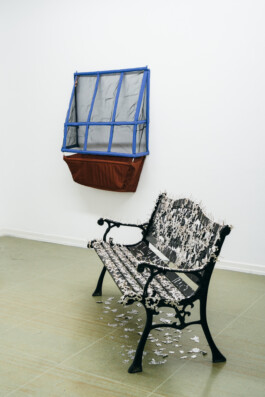












Nadjana Mohr
Scratch, love, let gravity win, 2025
Romantically inviting – or as a defensive construction against any long-term settlement of humans and animals – images of burning benches in fire and rubble, piled up meters high, they fill up screens. In times of crisis, the bench becomes a barricade, a demarcation of the terrain of a conflict, a refuge – a missed refuge. A bench is a meeting place and negotiates the merging and demarcation of users in equal measure. With each installation, a little more material is added.
untitled (Framed Hooks), 2025 Hooks In My Mind / 2025
The edition Hooks In My Mind outlines the mechanisms between physical defence and aesthetic attraction in a small collection. It contains sketches of thorns and spikes based on AI, as well as stock templates of roses, acacias, holly, blackberries, sloes and black locusts, all with a shiny metallic finish. The cover is made of tin on recycled cardboard and contains tinted watercolour paper. By covering sharp shapes and translating them into metal, a piece is created that negotiates the boundaries between approachability and fragility, falling somewhere between an art object and a booklet.
Gesa Kolb
Oriel I, Oriel II , 2025
Inspired by bay windows (oriel) and conservatories that Kolb found in various cities, Oriel I and II appear as a hybrid of architecture and costume. Based on the construction methods of Victorian crinolines, the two wall objects simultaneously open up a volume and the space behind them. The fragility of the fabrics is also intended to refer to the fragility of the rooms that the oriels enclose/protect. The mostly single-walled glass panes of the oriels are emphasized by the thin silk of the ‘oriel windows’, which have been patched in some places and replaced with different ‚glass’ piecings. The underside of the bay windows also does not convey stability, but rather becomes a pendant attached to the ‘window’ with a carabiner hook.
Darcy Neven
Search for meaningful rituals, Pt 1., 2025
“A search for meaningful rituals, to honor the sacred human lives that are being sacrificed every day. Creating space to allow Death to teach us: to awaken us to the reality of a system whose atrocities know no bounds. In acknowledging Death, I want to honor my own aliveness. My capability of hope and love.
So, in a world with so much war, violence, greed and separation: I invite people to eat together.
Because everyone who grew up in a conflicted home, knows the dinner table is not a neutral territory. Many of us have complicated relationships with food and our bodies. We rarely know where our food is being grown, nor who grew it. In Sudan more than 50 000 children have starved to death. In Gaza, food is one of the biggest weapons of the genocide. More than 1/3 of the food being grown or produced, is being wasted, while millions go hungry. Food is political.
Growing food and tending to a garden is political, not a hobby. It is a protest and it is the solution at the same time. When we become aware, the dinner table can become a weapon of change. Food can be a bridge, to slowly mend the disconnect the system feeds on. And to remember the magic in everyday life.
The wisdom of the water will make us remember our capability to move with what is. It will gently heal our bodies, yet has the power to carve a new path over time: just like our choices.
Guten Appetit, smakelijk eten: May it nourish your soul.”
Darcy Neven, Cologne 2025
Vitrines
Gesa Kolb
Clematis, a Window Frame and a Curled Curtain, 2025
The installation ‘Clematis, a Window Frame and a Curled Curtain’ plays with the conditions of the exhibition space and the motif of still life. The display case, similar to a bay window (see ‘Oriel I + II’), serves as both a window and a stage. The work creates a doubling in several aspects. The format of the window colour drawing corresponds in size to the cut out part of the wall object, and the curved shapes of the abstracted drawing of clematis seeds are repeated in the twisted form of the curtain in the ‘window frame’. Kolb discovered the clematis motif during walks in and around the city, where it grows wild, mostly in abandoned, undeveloped places such as former industrial areas and construction sites. It is often found together with wild blackberries, to which Nadjana Mohr's work in the same display case alludes.
Nadjana Mohr
Portal, 2025
The installation Portal focuses on familiar and mythical (inner) places. In times marked by unrest, the work conveys connections between ancient myths and customs and those of the present. Shepherds would send their flocks under blackberry bushes so that all evil would stick to them, or they would weave the blackberries into a wreath so that those wearing the blackberry crown could recognize witches. The work Portal seeks connections to current social developments and trends, reinterpreting mysticism and conjuring up modern superstitions. Portal aims to be the gateway to the sought "missing piece"—the vanished element in the enchanted—which, as expected, rests in the grandparents' basement or in the untidy part of the garden shed—or in the White Cube.
Darcy Neven
I want to go back playing, 2025
In an interview, the Palestinian journalist Bisan spoke about her 5 year old niece, who was sad and tired about the dire situation they have been living in and mentioned that she “wanted to go back to playing.” As all children should.
And adults too. As I was building my “professional artistic practice” I was noticing my own playfulness becoming less. High expectations, fear to fail or make mistakes and moving from the mind took the lead. Pleasure and joy became concepts of the mind. Needless to say: I was becoming more and more unhappy. This Palestinian child broke my heart, but inspired me to reconnect to this magical and hopeful, childlike part in myself.
When I was a child, my uncle build a wooden dollhouse for me and my sister. It was very big, with a balcony, windows and carpet floors. When we were older the house was sold without our permission but the house stayed with me, as a ghost, a lost family member or a secret longing.
I was fantasizing about re-creating this house, but even more magical.
Without prefabricated, plastic furniture that unconsciously conditions my future children on how a home should look like or how life should be lived. But a home that is warm and welcoming, where spirit can be found in everything and children will never doubt that magic exists. A home which is connected to Nature, because we are Nature.
I started questioning how community would look like if we were not conditioned by the concept of “nuclear familiy” in patriarchal, post-Christianity, colonialist capitalism? What would we value?
How would we live?
What would be meaningful skills to acquire? If we were not surviving?
Where would our attention go? How would we spend our time?
What would the world look like if we would be well-rested?
Would we consider life sacred again?
How does life look like if we question tradition, safety and normalcy?
Can we see beyond the illusions that have been presented to us as “reality?” Are we able to question our conditioning and indoctrination and live the life that pleases us?
How do we unlearn?
How do we say no?
“By playing” the Palestinian children showed me.
I believe we owe it to all the children, who are unable to play in safety: to undo our mental occupation so we can dream up new ways living and loving on this planet, together.
This is the spiritual Revolution of the Heart.
kuratiert von, curated by Lisa Oord
Mit freundlicher Unterstützung von, Kindly supported by
Stadt Köln & Sparkasse Köln Bonn